Makita DHR171Z Manual

|
EN |
Cordless Rotary Hammer |
INSTRUCTION MANUAL |
6 |
|
|
|
|
|
|
|
Perforateur Sans Fil |
MANUEL D’INSTRUCTIONS |
12 |
|
FR |
|||
|
|
|
|
|
|
|
Akku-Bohrhammer |
BETRIEBSANLEITUNG |
19 |
|
DE |
|||
|
|
|
|
|
|
|
Martello rotativo a batteria |
ISTRUZIONI PER L’USO |
26 |
|
IT |
|||
|
|
|
|
|
|
|
Accuboorhamer |
GEBRUIKSAANWIJZING |
33 |
|
NL |
|||
|
|
|
|
|
|
|
Martillo Rotativo Inalámbrico |
MANUAL DE |
40 |
|
ES |
|||
|
|
|
INSTRUCCIONES |
|
|
|
|
|
|
|
|
Martelete Rotativo a Bateria |
MANUAL DE INSTRUÇÕES |
47 |
|
PT |
|||
|
|
|
|
|
|
|
Akku-borehammer |
BRUGSANVISNING |
53 |
|
DA |
|||
|
|
|
|
|
|
|
Φορητό σφυροτρύπανο |
ΕΓΧΕΙΡΙΔΙΟ ΟΔΗΓΙΩΝ |
59 |
|
EL |
|||
|
|
|
|
|
|
|
Akülü Kırıcı Delici |
KULLANMA KILAVUZU |
66 |
|
TR |
|||
|
|
|
|
|
DHR171
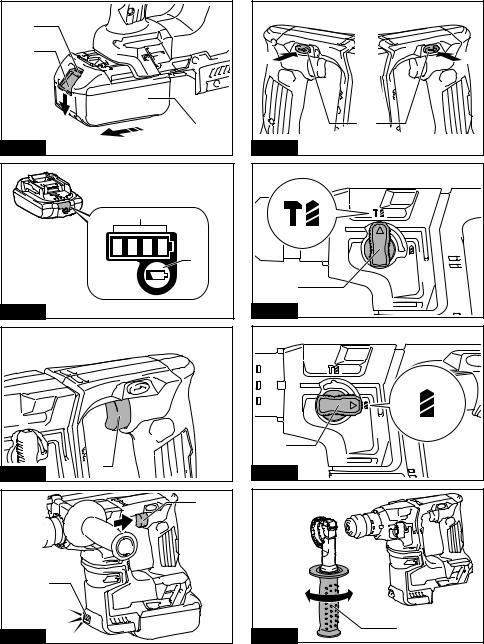
1 |
2 |
3 |
Fig.1 |
1 |
2 |
Fig.2 |
Fig.3 |
1 |
|
|
|
1 |
2
Fig.4
A |
B |
|
1 |
Fig.5 |
|
1 |
Fig.6 |
1 |
Fig.7 |
Fig.8 |
1 |
|
2
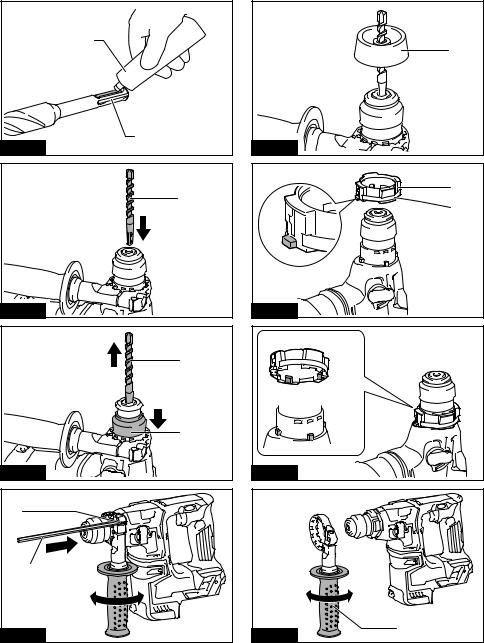
2 |
1 |
Fig.9 |
1 |
Fig.10 |
1 |
2 |
Fig.11 |
1 |
2 |
Fig.12 |
3 |
1 |
Fig.13 |
1 |
2 |
Fig.14 |
Fig.15 |
Fig.16 |
1 |
|
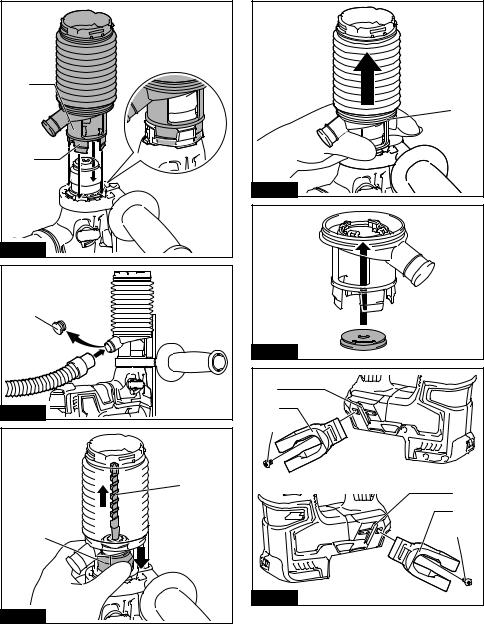
1 |
2 |
Fig.17 |
1 |
Fig.18 |
1 |
2 |
Fig.19 |
4 |
1 |
Fig.20 |
Fig.21 |
1 |
2 |
3 |
1
2
3
Fig.22
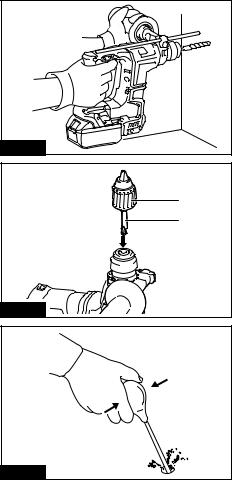
Fig.23 |
1 |
2 |
Fig.24 |
Fig.25 |
5

ENGLISH (Original instructions)
SPECIFICATIONS
Model: |
|
DHR171 |
Drilling capacities |
Concrete |
17 mm |
|
Steel |
10 mm |
|
Wood |
13 mm |
No load speed |
|
0 - 680 min-1 |
Blows per minute |
|
0 - 4,800 min-1 |
Overall length |
|
273 mm |
Rated voltage |
|
D.C. 18 V |
Standard battery cartridge |
|
BL1815N / BL1820 / BL1820B / BL1830 / BL1830B / BL1840 / |
|
|
BL1840B / BL1850 / BL1850B / BL1860B |
Net weight |
|
2.1 - 2.8 kg |
•Due to our continuing program of research and development, the specifications herein are subject to change without notice.
•Specifications and battery cartridge may differ from country to country.
•The weight may differ depending on the attachment(s), including the battery cartridge. The lightest and heaviest combination, according to EPTA-Procedure 01/2014, are shown in the table.
Intended use
The tool is intended for hammer drilling and drilling in brick, concrete and stone.
It is also suitable for drilling without impact in wood, metal, ceramic and plastic.
Noise
The typical A-weighted noise level determined according to EN60745:
Sound pressure level (LpA) : 86 dB(A) Sound power level (LWA) : 97 dB (A) Uncertainty (K) : 3 dB(A)

 WARNING: Wear ear protection.
WARNING: Wear ear protection.
Vibration
The vibration total value (tri-axial vector sum) determined according to EN60745:
Work mode: hammer drilling into concrete
Vibration emission (ah, HD): 9.0 m/s2 Uncertainty (K) : 1.5 m/s2
Work mode: drilling into metal
Vibration emission (ah,D) : 2.5 m/s2 or less Uncertainty (K) : 1.5 m/s2
NOTE: The declared vibration emission value has been measured in accordance with the standard test method and may be used for comparing one tool with another.
NOTE: The declared vibration emission value may also be used in a preliminary assessment of exposure.
 WARNING: The vibration emission during actual use of the power tool can differ from the declared emission value depending on the ways in which the tool is used.
WARNING: The vibration emission during actual use of the power tool can differ from the declared emission value depending on the ways in which the tool is used.
 WARNING: Be sure to identify safety measures to protect the operator that are based on an estimation of exposure in the actual conditions of use (taking account of all parts of the operating cycle such as the times when the tool is switched off and when it is running idle in addition to the trigger time).
WARNING: Be sure to identify safety measures to protect the operator that are based on an estimation of exposure in the actual conditions of use (taking account of all parts of the operating cycle such as the times when the tool is switched off and when it is running idle in addition to the trigger time).
EC Declaration of Conformity
For European countries only
The EC declaration of conformity is included as Annex A to this instruction manual.
SAFETY WARNINGS
General power tool safety warnings
 WARNING: Read all safety warnings, instructions, illustrations and specifications provided with this power tool. Failure to follow all instructions listed below may result in electric shock, fire and/or serious injury.
WARNING: Read all safety warnings, instructions, illustrations and specifications provided with this power tool. Failure to follow all instructions listed below may result in electric shock, fire and/or serious injury.
Save all warnings and instructions for future reference.
The term "power tool" in the warnings refers to your mains-operated (corded) power tool or battery-operated (cordless) power tool.
6 ENGLISH

CORDLESS ROTARY HAMMER SAFETY WARNINGS
1.Wear ear protectors. Exposure to noise can cause hearing loss.
2.Use auxiliary handle(s), if supplied with the tool. Loss of control can cause personal injury.
3.Hold power tool by insulated gripping surfaces, when performing an operation where the cutting accessory may contact hidden wiring.
Cutting accessory contacting a "live" wire may make exposed metal parts of the power tool "live" and could give the operator an electric shock.
4.Wear a hard hat (safety helmet), safety glasses and/or face shield. Ordinary eye or sun glasses are NOT safety glasses. It is also highly recommended that you wear a dust mask and thickly padded gloves.
5.Be sure the bit is secured in place before operation.
6.Under normal operation, the tool is designed to produce vibration. The screws can come loose easily, causing a breakdown or accident. Check tightness of screws carefully before operation.
7.In cold weather or when the tool has not been used for a long time, let the tool warm up for a while by operating it under no load. This will loosen up the lubrication. Without proper warm-up, hammering operation is difficult.
8.Always be sure you have a firm footing. Be sure no one is below when using the tool in high locations.
9.Hold the tool firmly with both hands.
10.Keep hands away from moving parts.
11.Do not leave the tool running. Operate the tool only when hand-held.
12.Do not point the tool at any one in the area when operating. The bit could fly out and injure someone seriously.
13.Do not touch the bit, parts close to the bit, or workpiece immediately after operation; they may be extremely hot and could burn your skin.
14.Some material contains chemicals which may be toxic. Take caution to prevent dust inhalation and skin contact. Follow material supplier safety data.
SAVE THESE INSTRUCTIONS.
 WARNING: DO NOT let comfort or familiarity with product (gained from repeated use) replace strict adherence to safety rules for the subject product. MISUSE or failure to follow the safety rules stated in this instruction manual may cause serious personal injury.
WARNING: DO NOT let comfort or familiarity with product (gained from repeated use) replace strict adherence to safety rules for the subject product. MISUSE or failure to follow the safety rules stated in this instruction manual may cause serious personal injury.
Important safety instructions for battery cartridge
1.Before using battery cartridge, read all instructions and cautionary markings on (1) battery charger, (2) battery, and (3) product using battery.
2.Do not disassemble battery cartridge.
3.If operating time has become excessively shorter, stop operating immediately. It may result in a risk of overheating, possible burns and even an explosion.
4.If electrolyte gets into your eyes, rinse them out with clear water and seek medical attention right away. It may result in loss of your eyesight.
5.Do not short the battery cartridge:
(1)Do not touch the terminals with any conductive material.
(2)Avoid storing battery cartridge in a container with other metal objects such as nails, coins, etc.
(3)Do not expose battery cartridge to water or rain.
A battery short can cause a large current flow, overheating, possible burns and even a breakdown.
6.Do not store the tool and battery cartridge in locations where the temperature may reach or exceed 50 °C (122 °F).
7.Do not incinerate the battery cartridge even if it is severely damaged or is completely worn out. The battery cartridge can explode in a fire.
8.Be careful not to drop or strike battery.
9.Do not use a damaged battery.
10.The contained lithium-ion batteries are subject to the Dangerous Goods Legislation requirements.
For commercial transports e.g. by third parties, forwarding agents, special requirement on packaging and labeling must be observed.
For preparation of the item being shipped, consulting an expert for hazardous material is required.
Please also observe possibly more detailed national regulations.
Tape or mask off open contacts and pack up the battery in such a manner that it cannot move around in the packaging.
11.Follow your local regulations relating to disposal of battery.
SAVE THESE INSTRUCTIONS.
 CAUTION: Only use genuine Makita batteries.
CAUTION: Only use genuine Makita batteries.
Use of non-genuine Makita batteries, or batteries that have been altered, may result in the battery bursting causing fires, personal injury and damage. It will also void the Makita warranty for the Makita tool and charger.
Tips for maintaining maximum battery life
1.Charge the battery cartridge before completely discharged. Always stop tool operation and charge the battery cartridge when you notice less tool power.
2.Never recharge a fully charged battery cartridge. Overcharging shortens the battery service life.
3.Charge the battery cartridge with room temperature at 10 °C - 40 °C (50 °F - 104 °F). Let a hot battery cartridge cool down before charging it.
4.Charge the battery cartridge if you do not use it for a long period (more than six months).
7 ENGLISH
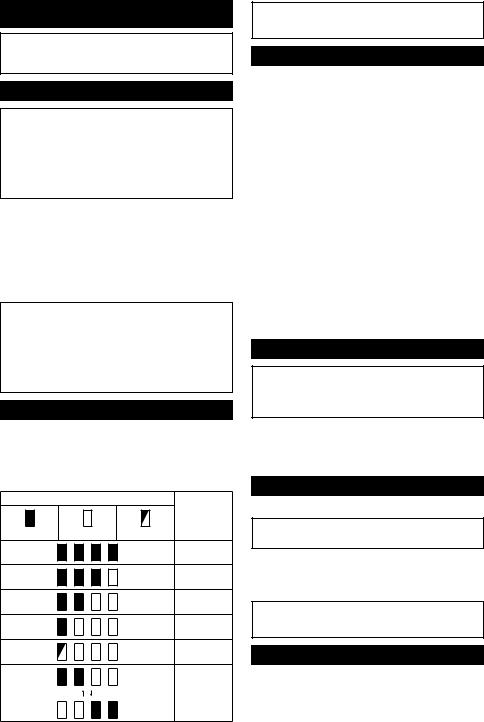
FUNCTIONAL DESCRIPTION
 CAUTION: Always be sure that the tool is switched off and the battery cartridge is removed before adjusting or checking function on the tool.
CAUTION: Always be sure that the tool is switched off and the battery cartridge is removed before adjusting or checking function on the tool.
Installing or removing battery cartridge
 CAUTION: Always switch off the tool before installing or removing of the battery cartridge.
CAUTION: Always switch off the tool before installing or removing of the battery cartridge.
 CAUTION: Hold the tool and the battery cartridge firmly when installing or removing battery cartridge.
CAUTION: Hold the tool and the battery cartridge firmly when installing or removing battery cartridge.
Failure to hold the tool and the battery cartridge firmly may cause them to slip off your hands and result in damage to the tool and battery cartridge and a personal injury.
► Fig.1: 1. Red indicator 2. Button 3. Battery cartridge
To remove the battery cartridge, slide it from the tool while sliding the button on the front of the cartridge.
To install the battery cartridge, align the tongue on the battery cartridge with the groove in the housing and slip it into place. Insert it all the way until it locks in place with a little click. If you can see the red indicator on the upper side of the button, it is not locked completely.
 CAUTION: Always install the battery cartridge fully until the red indicator cannot be seen. If not, it may accidentally fall out of the tool, causing injury to you or someone around you.
CAUTION: Always install the battery cartridge fully until the red indicator cannot be seen. If not, it may accidentally fall out of the tool, causing injury to you or someone around you.
 CAUTION: Do not install the battery cartridge forcibly. If the cartridge does not slide in easily, it is not being inserted correctly.
CAUTION: Do not install the battery cartridge forcibly. If the cartridge does not slide in easily, it is not being inserted correctly.
Indicating the remaining battery capacity
Only for battery cartridges with the indicator
► Fig.2: 1. Indicator lamps 2. Check button
Press the check button on the battery cartridge to indicate the remaining battery capacity. The indicator lamps light up for a few seconds.
|
Indicator lamps |
Remaining |
|
|
capacity |
Lighted |
Off |
Blinking |
|
|
75% to 100% |
|
|
50% to 75% |
|
|
25% to 50% |
|
|
0% to 25% |
|
|
Charge the |
|
|
battery. |
|
|
The battery |
|
|
may have |
|
|
malfunctioned. |
NOTE: Depending on the conditions of use and the ambient temperature, the indication may differ slightly from the actual capacity.
Tool / battery protection system
The tool is equipped with a tool/battery protection system. This system automatically cuts off power to the motor to extend tool and battery life. The tool will automatically stop during operation if the tool or battery is placed under one of the following conditions:
Overload protection
When the battery is operated in a manner that causes it to draw an abnormally high current, the tool automatically stops without any indication. In this situation, turn the tool off and stop the application that caused the tool to become overloaded. Then turn the tool on to restart.
Overheat protection
When the tool or battery is overheated, the tool stops automatically and the lamp blinks. In this case, let the tool and battery cool before turning the tool on again.
Overdischarge protection
When the battery capacity is not enough, the tool stops automatically. In this case, remove the battery from the tool and charge the battery.
Switch action
 WARNING: Before installing the battery cartridge into the tool, always check to see that the switch trigger actuates properly and returns to the "OFF" position when released.
WARNING: Before installing the battery cartridge into the tool, always check to see that the switch trigger actuates properly and returns to the "OFF" position when released.
► Fig.3: 1. Switch trigger
To start the tool, simply pull the switch trigger. Tool speed is increased by increasing pressure on the switch trigger. Release the switch trigger to stop.
Lighting up the front lamp
► Fig.4: 1. Switch trigger 2. Lamp
 CAUTION: Do not look in the light or see the source of light directly.
CAUTION: Do not look in the light or see the source of light directly.
Pull the switch trigger to light up the lamp. The lamp keeps on lighting while the switch trigger is being pulled.
The lamp goes out approximately 10 seconds after releasing the switch trigger.
NOTE: Use a dry cloth to wipe the dirt off the lens of the lamp. Be careful not to scratch the lens of lamp, or it may lower the illumination.
Reversing switch action
► Fig.5: 1. Reversing switch lever
8 ENGLISH
